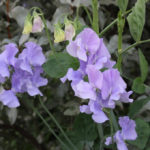If you once grew Lathyrus odoratus on your favorite cottage, inhaled its delicate vanilla aroma, admired the flowers that look like miniature copies of orchids, then you probably gave your heart to this sweet old flower forever.
And you can be understood! The charm of Lathyrus odoratus knows no bounds: neither time nor garden fashion has any power over it. It captivates summer residents with its charming cuteness and sophistication. At the same time, modern varieties of ancient plants amaze the imagination of even sophisticated flower growers.

Let’s take a short historical digression into the past of Lathyrus odoratus. And then consider its current position in the ranking of garden flowers.
Historical dossier
True admirers of the exotic beauty and exquisite aroma of Lathyrus odoratus were and still are the British. His homeland is considered to be southern Italy (Sicily). It was from there that he got first to India, and then to Europe.

The British liked it so much that in 1900 they created a whole society of lovers of this southern fragrant beauty. Today, Lathyrus odoratus is the most popular flower plant in Albion, a kind of emblem of English garden design.

And Lathyrus odoratus is usually understood as 2 species: Lathyrus latifolius and Lathyrus odoratus, calling all Sweet Pea.

Botanical dossier
Lathyrus odoratus is an annual herb with a height of 15 cm to 2.5 m, with ribbed stems. The leaves are complex, feathery, bright green, ending in a tendril, which the plant clings to the support.
Moth flowers, fragrant, elegant shape, diameter of 3.5 cm, a variety of colors (from light blue to dark blue and purple, there are only yellow), collected in brushes of 3-12 PCs.

Brushes appear from the axils of the leaves of the main shoot: starting from 9 node-in early varieties, in late varieties-from 16-18. Blooms from late June (or early July) to September. On average, the duration of flowering is 45-60 days. Fruits-pubescent beans 5-7 cm long, with 3-6 seeds. Warning! The seeds of Lathyrus odoratus are poisonous!
Varieties
Currently, the world assortment includes more than 1000 varieties with flowers of white, pink, red, blue, blue, orange colors. Breeders often combine them into groups. Two-color varieties (Burgundy+white, blue+purple, pink+Burgundy) are now confident sales leaders on the world market.
Breeders worked hard not only on the variety of colors of flowers. There were varieties with a fringed edge of petals, Terry cultivars.
In appearance, Lathyrus odoratus varieties are divided into short or dwarf varieties (15-80 cm high) that do not require support. Examples:
- ‘Cupid’ (30-40 cm high, white-pink flowers, fragrant).

Medium-sized (80-100 cm high), which are tied up when lying down. Examples:
- ‘Knee-hi Group’ (in brushes of 4 flowers, a mixture of colors);
- ‘Continental Group’ (in brushes of 5 flowers, a mixture of colors).

Tall (1-2. 5 m high) that need support and direction of shoots. Examples:
- ‘Multiflora Gigantea’ (characterized by early flowering, corrugated petals, a mixture of colors);
- group ‘Spenser’ (flower stalks up to 15 cm long, a mixture of colors);
- ‘Galaxy Group’ (in brushes of 8 flowers, a mixture of colors).

What Lathyrus odoratus likes
All types and varieties prefer:
- Sunny, wind-protected summer cottages;
- the soil is deeply worked, fertile, neutral. For growing in containers (pots), the optimal composition of the soil substrate is humus, leaf soil and sand (1:2:3);
- abundant regular watering;
- systematic feeding with liquid organic fertilizer.
What Lathyrus odoratus doesn’t like
You can’t call a plant capricious, but it still can’t stand it:
- the lack of moisture (reacts with abscission of buds);
- permanent location (it is better to return it to the previous landing site no earlier than 5 years).
Seed reproduction
Propagated by seeds (1 g contains 8-15 PCs.). Sowing for seedlings in February-March, in separate containers.

In the South, you can immediately sow in open ground: dry, without soaking – in March-April, with soaking – in may.
Summer residents of other regions will have to grow seedlings. Before sowing, the seeds are soaked in hot water, left in it for 10 hours, then kept in sawdust for 3-4 days at a temperature of +18…+20°C for germination. The swollen seeds are sown in peat pots. The soil substrate consists of a mixture of peat, humus, turf and sand (2:2:2:1), sealing depth – 2 cm.

In may, seedlings of Lathyrus odoratus are carefully transferred to the open ground.
Practical advice: do not store Lathyrus odoratus seeds for a long time: their germination lasts from 2 to 5 years.
Accommodation in the country
The rich amplitude of height, all possible (except yellow) color of flowers and a wonderful delicate aroma are the indisputable advantages of Lathyrus odoratus. They allow you to use this plant in a variety of elements of garden design. Undersized or dwarf varieties can be planted as a flower border, in the foreground of landscape flower beds, and even in rockeries. They look great in various vases.

Tall varieties are ideal for vertical gardening, creating accents in flower beds on various types of supports.

It lavishly looks like on wrought iron trellis, or on simple supports.

Lathyrus odoratus is a truly Royal flower! Even on village fences, it looks respectable.

Practical advice: to fully enjoy the subtle aroma of Lathyrus odoratus, it should be planted at the level of the face.

In addition, it can be used to decorate a balcony or loggia, to make a shade of the gazebo to create a hedge.
Lathyrus odoratus can be used in cutting to create beautiful fragrant bouquets, including wedding ones (based on pastel varieties).

If you update the cut of the stems daily and change the water in the vase, the bouquet will stand for more than a week!
And finally, traditional questions. Does Lathyrus odoratus grow in your cottage? What varieties of it do you like the most?

















